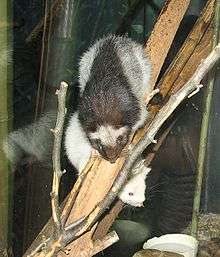Northern Luzon giant cloud rat
The northern Luzon giant cloud rat (Phloeomys pallidus) is a large species of rodent in the family Muridae that is endemic to the Luzon Island of the Philippines.[1]
| Northern Luzon giant cloud rat | |
|---|---|
 | |
| Scientific classification | |
| Kingdom: | Animalia |
| Phylum: | Chordata |
| Class: | Mammalia |
| Order: | Rodentia |
| Family: | Muridae |
| Genus: | Phloeomys |
| Species: | P. pallidus |
| Binomial name | |
| Phloeomys pallidus Nehring, 1890 | |
 | |
Description
Phylogeny
This large murid rodent is large, around 2.5 kg, and therefore cannot be captured with standard small mammal traps.[3] This has hindered the ability of researchers to thoroughly study this species.
Phloeomys pallidus and Phloeomys cumingi are the only two recognized species in the genus Phloeomys.[4] They are in the family Muridae, in the order Rodentia. Rodentia is the most diverse mammalian family.
Appearance
Cloud rats (genus Phloeomys) are distinguished from all other murid rodents by their densely furred tails.[4] Phloeomys pallidus is distinguished from its relative Phloeomys cumingi by its slender tail (P. cumingi have bushy tails).[4] P. pallidus has long, dense pelage that is highly variable in color and pattern.[4] The pelage is usually white with a black mask and collar, but can also be entirely white.[4]
Ecology
Distribution and Habitat
P. pallidus is a highly adaptable species of rodent, as it is able to thrive in extremely degraded habitats.[4] They are often considered pests because they inhabit agricultural land that has replaced natural habitat.[5] P. pallidus is known to cause extensive damage to rice crops.[5]
The slender-tailed cloud rat (P. pallidus) has a larger habitat range than the bushy-tailed cloud rat (P. cumingi); P. pallidus is found in at least 12 provinces of Luzon,[4] the largest and oldest island in the Philippines.[3] P. pallidus is endemic to Luzon, occurring only in the central and northern areas of the island.[1] P. pallidus uses both secondary and primary lowland forest[1] and has been found at elevations between sea-level and about 2000 meters.[4] Like many rodents, P. pallidus is nocturnal.[6]
Physiology
Reproduction
P. pallidus often live in pairs with one or two dependent young.[4] They give birth in hollow boles of trees (standing or fallen) or in burrows in the ground.[4] The sperm head of P. pallidus has a short apical hook, with the sperm tail attached off-center basally.[7] The tail of a P. pallidus sperm is about 127 µm long.[7]
Human Interaction
Hunting
P. pallidus are hunted regularly in the Sierra Madre.[1] They are sometimes extensively hunted for food (bushmeat) by the local people.[4] Although hundreds are hunted annually, they are still locally abundant.[4] Perhaps hunting improves the health of the populations. Additionally, P. pallidus is known to cause extensive damage to rice crops.[5]
References
- 1 2 3 4 Duya; et al. (2007). "Report on a Survey of Mammals of the Sierra Madre Rance, Luzon Island, Philippines". Banwa. 4: 41–68.
- ↑ Heaney, L.; Balete, D.; Rosell-Ambal, G.; Tabaranza, B.; Ong, P.; Ruedas, L. & Oliver, W. (2008). "Phloeomys pallidus". IUCN Red List of Threatened Species. Version 2010.4. International Union for Conservation of Nature. Retrieved 10 June 2011.
- 1 2 Duya; et al. (2011). "Chapter 4: Diversity of Small Mammals in Montane and Mossy Forests on Mount Cetaceo, Cagayan Province, Luzon". Fieldiana: Live and Earth Sciences. 2: 88–95.
- 1 2 3 4 5 6 7 8 9 10 11 12 Oliver; et al. (1993). "Cloud rats in the Philippines--preliminary report on distribution and status". Oryx. 27: 41–48.
- 1 2 3 Singleton, Ravindra, and Sebastian (2008). Philippine Rats: ecology and management. PhilRice.
- ↑ "Synopsis of Philippine Mammals". 2010.
- 1 2 Breed; et al. (2010). "The spermatozoon of the Old Endemic Australo-Papuan and Philippine rodents--its morphological diversity and evolution". Acta Zoologica. 91: 279–294.
